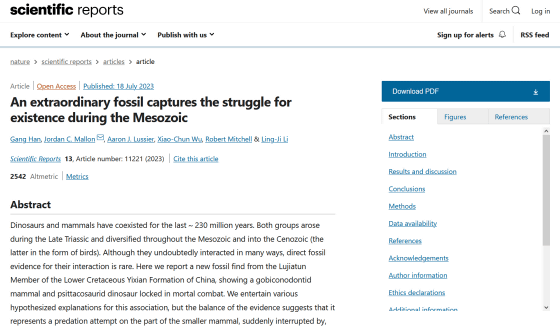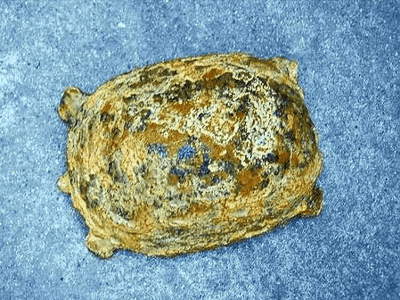Fossils that record the moment of 'dinosaurs VS mammals' are found, the possibility that mammals were surprisingly dominant

A paper on fossils that preserved the battle between `` dinosaurs VS mammals '' that occurred about 125 million years ago was published in the academic journal Scientific Reports. Mammals in
An extraordinary fossil captures the struggle for existence during the Mesozoic | Scientific Reports
https://doi.org/10.1038/s41598-023-37545-8

Unusual fossil shows rare evidence of a mamma | EurekAlert!
https://www.eurekalert.org/news-releases/995575
Final moments of dinosaur and mammal's epic 'mortal combat' battle preserved by volcanic eruption |
https://www.livescience.com/planet-earth/fossils/final-moments-of-dinosaur-and-mammals-epic-mortal-combat-battle-preserved-by-volcanic-eruption
It Turns Out An Ancient Creature Actually Preyed Upon Dinosaurs : ScienceAlert
https://www.sciencealert.com/it-turns-out-an-ancient-creature-actually-preyed-upon-dinosaurs
In 2012, some 125-million-year-old fossils containing nearly complete dinosaur and mammalian bodies were unearthed in northeastern China's Liaoning province . During the Mesozoic Era, volcanic activity was active in the area of modern Liaoning Province, and this fossil has been preserved as a complete fossil of a living creature covered in volcanic mudflows in which volcanic ash and lava mixed with water. It was discovered in a stratum called Dinosaur Pompeii.
The dinosaur is Psittacosaurus lujiatunensis, a type of herbivorous dinosaur Psittacosaurus characterized by a beak like a parrot. It has been identified as Repenomamus robustus.
The fossils in the photo are below. You can see Psittacosaurus with its head on the left side and Repenomamus clinging to it. The total length including the tail of Psittacosaurus is about 120 cm, and the total length of Repenomamus is about 47 cm. Since all of them become larger when they become adults, it is believed that the individuals that became fossils this time were in the process of growing.

This is a picture that clearly shows the head and legs of Repenomamus. Psittacosaurus has its hind legs folded and curled up, with Repenomamus' front legs entwined in its beak, Repenomamus' head around its chest, and Repenomamus' hind legs around its shins.

If you look closely at the head of Repenomamus, you can see teeth digging into the ribs of Psittacosaurus. The research team pointed out that the skeleton of Psittacosaurus is well-organized, and it is unlikely that Repenomamus scavenged the carcass after it died, and that if it eats the carcass, the two bodies will not intertwine in this way. From these points, we concluded that this fossil is 'the mammal Repenomamus is attacking the dinosaur Psittacosaurus'.

Below is a sketch drawn by the research team imagining 'the appearance of Repenomamus and Psittacosaurus just before being buried in a volcanic lahar'. Smaller carnivores can defeat larger herbivores in the modern natural world, but there is a possibility that similar situations have occurred since the Mesozoic era.

There have been cases of Psittacosaurus bones being found in the stomachs of Repenomamus, but it is not possible to tell from these fossils whether Repenomamus ate the dead Psittacosaurus carcass or attacked and ate the Psittacosaurus. was. The fossils now show that Repenomamus likely was regularly attacking and eating Psittacosaurus.
'The two animals were closely intertwined in deadly combat, suggesting that the mammals acted as predators for the dinosaurs,' said study co-author Jordan Mallon, an archaeologist at the Canadian Museum of Nature. 'It's one of the first pieces of evidence. The coexistence of these two species is nothing new, but the predatory behavior shown through this amazing fossil is new.'
Related Posts:







